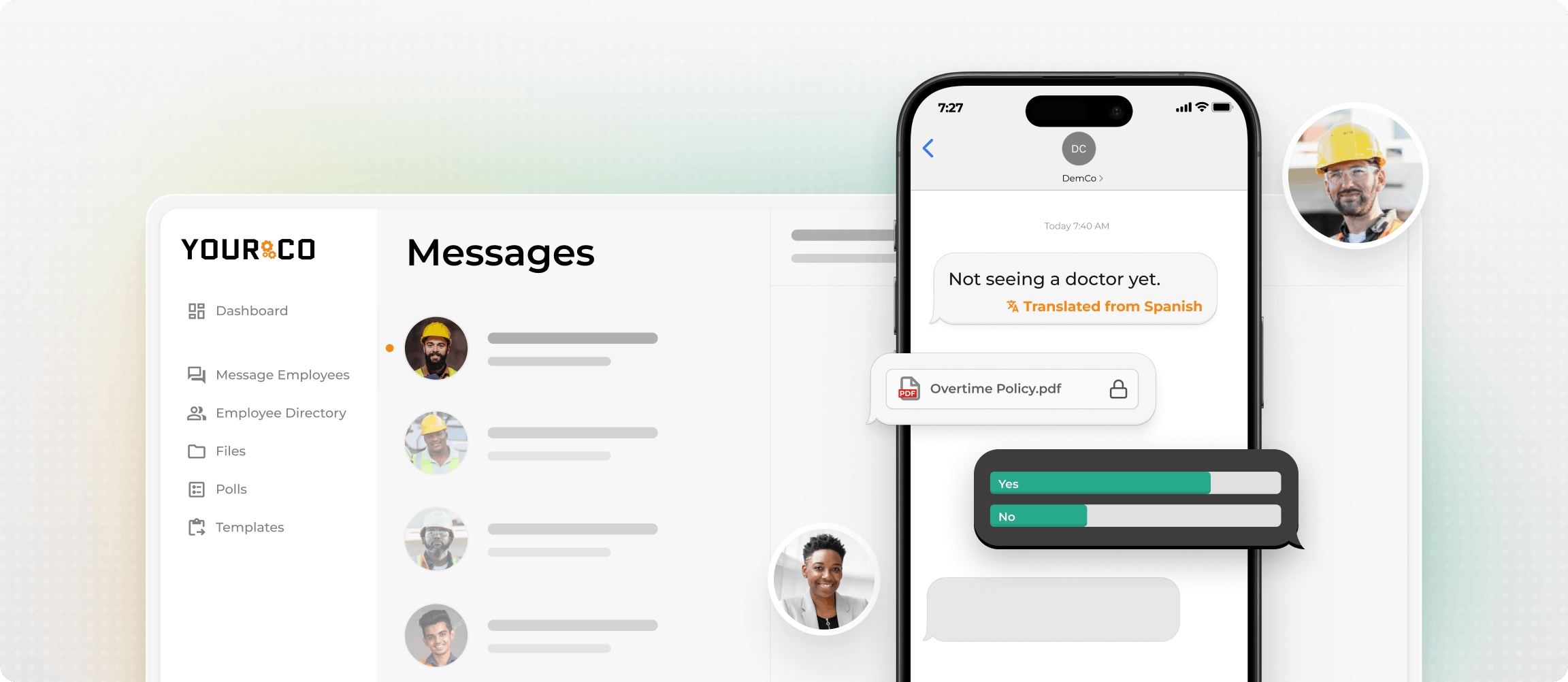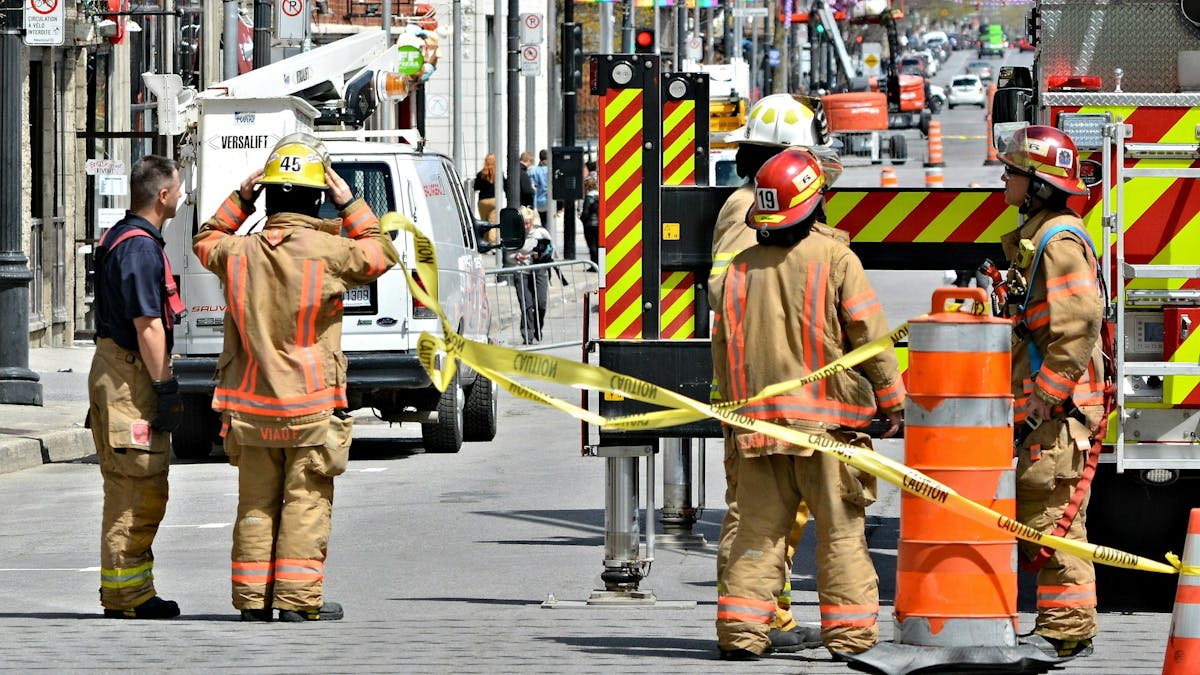What Info Should Be Documented in an Incident Log?


Incident logs are more than just paperwork. They serve as your first line of defense against risk, providing the foundation for regulatory compliance, legal protection, and continuous workplace improvement.
Inadequate incident documentation remains one of the top violations cited during workplace inspections, often resulting in costly penalties. Effective recordkeeping not only helps meet regulatory requirements but also uncovers hidden patterns, strengthens training programs, and prevents future incidents.
Modern communication technology makes it easier than ever to capture critical information. With 98% of text messages read compared to only 20% of emails, SMS-based reporting tools have become a reliable method for ensuring incident data gets collected, especially for dispersed, deskless, or field-based workforces.
This guide covers what belongs in effective incident logs, practical documentation approaches, and real-world examples showcasing proper reporting impacts.
→Download our free Incident Report Templates to standardize your reporting process and ensure every detail is captured accurately from the start.
The Purpose of an Incident Log
Incident logs provide systematic records of workplace accidents, near-misses, security breaches, and potential hazards. Thorough documentation forms the foundation for effective risk management and safety practices across industries.
Organizational Benefits
Good incident logs transform scattered information into actionable intelligence. They create transparency through a shared understanding of risks throughout your organization. This clear picture helps management allocate resources appropriately, identify training needs, and make informed safety investments.
Analyzing incident data reveals patterns invisible when examining individual events. These patterns highlight recurring hazards, procedural weaknesses, or training gaps that require systematic solutions. The documentation also supports new employee onboarding, guiding them through potential workplace dangers before they encounter them.
Organizations with mature incident logging systems report higher employee confidence in safety programs, leading to increased reporting rates and proactive hazard identification.
Companies can measure the effectiveness of safety initiatives through before-and-after incident data, proving the value of preventative measures to leadership teams and stakeholders.
Compliance and Legal Considerations
Thorough documentation demonstrates diligence, which is necessary for regulatory compliance in any industry. Well-maintained incident logs serve as powerful evidence during audits, inspections, and court cases.
Standard documentation shields your organization from liability through clear, objective records of events and responses. In legal matters, the difference between detailed and sloppy recordkeeping might determine case outcomes. Regulatory bodies across industries have specific documentation requirements with mandatory retention periods. OSHA, for example, requires maintaining certain records for five years.
Adhering to regulatory compliance guidelines ensures that organizations meet these requirements. Insurance companies often review incident logs when determining premiums, making good documentation financially beneficial.
The legal principle of "contemporaneous documentation" gives significant weight to information recorded at or near the time of an incident, emphasizing the importance of prompt reporting. Courts typically view consistent, detailed documentation as evidence of an organization's commitment to safety and compliance.
Essential Information to Document in an Incident Log
Comprehensive incident logs capture specific details to ensure complete records for analysis, prevention, and potential legal requirements.
Incident Details
Every incident log needs to capture basic information:
- WHO: Everyone involved (employees, contractors, visitors), witnesses, and reporters. Include names, roles, and contact information.
- WHAT: The incident type, equipment or materials involved, and affected systems. Specify what happened (injury, near-miss, property damage, etc.).
- WHEN: Date, time, and duration. Include time zones if your organization spans multiple locations.
- WHERE: Exact location, including work area, facility, floor/level, and equipment identifiers. Safety professionals recommend adding photos when possible.
- WHY: Early assessment of causes. Stick to facts without speculation or blame.
- HOW: Step-by-step sequence of events before, during, and after the incident.
Proper documentation should also note environmental conditions present during the incident, such as weather, lighting, noise levels, or other factors that might have contributed. Include equipment serial numbers, model information, and maintenance history when machinery is involved. Note any unusual circumstances, deviations from normal operations, or breaches of workplace safety rules that preceded the event. Precise timeline documentation helps establish causality and identify contributing factors.
Immediate Responses and Actions Taken
Document the initial response clearly:
- Emergency measures used (first aid, evacuation, shutdown procedures)
- Who was notified (supervisors, emergency services, regulatory bodies), and the methods used for alerting employees
- Containment strategies used
- Immediate fixes applied
List who responded and what they did, with timestamps. Tracking response timing can uncover gaps in emergency procedures. Using structured incident report templates ensures consistency in documenting these critical first responses.
Documentation should include details about any personal protective equipment used during the response, especially if it prevented injuries or reduced severity. Note any deviations from standard emergency response protocols and explain why they occurred.
Include information about which emergency response resources were activated, such as spill kits, fire suppression systems, or emergency stop mechanisms.
Outcomes and Consequences
Record what happened as a result:
- Injuries and their severity
- Property or equipment damage
- Operational disruptions (downtime, production losses)
- Financial losses (direct and estimated indirect costs)
- Environmental effects
Document any medical treatments, repairs, or cleanup efforts. Safety management experts advise putting numbers on impacts whenever possible to help prioritize future prevention efforts.
The documentation should include follow-up medical information such as diagnoses, prescribed treatments, and any work restrictions. Note secondary effects beyond immediate consequences, such as customer delivery impacts, overtime costs, or rescheduling requirements.
Track all regulatory notifications that resulted from the incident with dates, contact names, and report numbers. Document reputational impacts if applicable, especially for incidents affecting public spaces or receiving media attention.
Lastly, note any psychological effects on employees who witnessed traumatic incidents, including referrals to employee assistance programs. This detailed outcomes tracking helps organizations fully understand incident costs beyond obvious direct expenses.
Witness Statements
Gather firsthand accounts from all witnesses, ideally in their own words. For each statement, include:
- Contact information
- Where they were standing relative to the incident
- Direct quotes when possible
- When the statement was collected
Witness statements should note whether the person has specialized knowledge or training relevant to understanding what happened. Document each witness's familiarity with involved processes, equipment, or procedures. Collect statements as soon as possible after the incident while memories remain fresh.
Note each witness's emotional state during statement collection, as this can affect recall accuracy. Use open-ended questions that avoid suggesting answers, and document these questions along with responses. Consider creating scaled diagrams showing witness positions relative to the incident.
If possible, have witnesses review and sign their statements to confirm accuracy. For complex incidents, follow-up interviews might be necessary after initial information analysis reveals additional questions.
Common Pitfalls in Incident Documentation
Organizations often struggle with these documentation challenges:
Delayed Reporting
Information quality fades quickly after incidents. Set immediate reporting expectations and provide tools that work in all environments.
Documentation quality deteriorates significantly with every hour that passes after an incident. Organizations successfully addressing this issue implement multiple reporting channels (phone, text, app, verbal) to accommodate different situations. Some companies incentivize prompt reporting through recognition programs that track reporting timeliness.
Effective organizations establish maximum timeframes for initial reports (often 24 hours), with the understanding that preliminary information can be updated later. Training should emphasize the importance of capturing basic details immediately rather than waiting until a complete report can be assembled. This applies to all types of safety events, including near-miss incidents that might otherwise go unreported.
Incomplete Information
Partial documentation creates liability risks and missed improvement opportunities. Use structured templates with required fields and train staff on what information matters.
Many organizations implement electronic forms with mandatory fields that prevent submission of incomplete reports. Smart forms that adapt based on incident type can prompt for specific details relevant to particular situations. Successful programs include a quality check step where supervisors or safety personnel review submissions for completeness before acceptance.
Organizations should establish clear standards for what constitutes "complete" documentation and train all staff accordingly. Regular audits of documentation completeness help identify systemic gaps requiring additional training or form modifications. Companies with effective programs maintain libraries of well-documented examples that demonstrate the expected level of detail.
Subjective Language
Opinion-based documentation can weaken the credibility of safety reports and lead to misinterpretation. Training staff to differentiate between facts and interpretations is critical, and reports should emphasize observable behaviors rather than assumptions or judgments.
For instance, replacing "he was careless" with "he was running through the warehouse" ensures clarity and objectivity. Many organizations include role-playing or side-by-side comparison exercises in training to help employees identify and correct subjective phrasing. Peer review processes can also reinforce accountability by encouraging staff to review each other's reports for accuracy and neutrality before submission.
Supervisors are essential in modeling proper documentation standards and providing real-time feedback. Clear, factual reporting not only improves internal communication but also strengthens legal and compliance documentation.
Lack of Follow-Up
Incident logs without resolution tracking become paperwork exercises rather than improvement tools. Verify that corrective actions are documented and completed.
Effective organizations implement action tracking systems that assign responsibility for each corrective measure with deadlines. Regular review meetings examine outstanding actions and address barriers to completion. The most successful programs include effectiveness verification that confirms whether implemented actions actually reduced risk.
Documentation should include both immediate corrective actions and systemic improvements addressing root causes. Escalation protocols ensure that overdue actions receive appropriate management attention.
Organizations should establish clear closure criteria that define when an incident can be considered fully resolved. Tracking systems should connect related incidents, showing patterns even when individual events occur in different departments.
Siloed Information
When incident data stays trapped in departmental systems, organization-wide patterns remain hidden. Create central visibility while maintaining appropriate access controls.
Progressive organizations implement enterprise-wide incident management systems with role-based access controlling who sees sensitive details. Integration between safety, maintenance, quality, and human resources systems enables comprehensive analysis across traditional boundaries.
Effective programs include standardized classification frameworks ensuring consistent categorization regardless of which department documents the incident. Regular cross-functional safety meetings review incidents from all departments to identify common themes.
Organizations should establish data sharing agreements that balance privacy concerns with the need for comprehensive analysis. The most advanced systems include automatic pattern detection algorithms that identify connections human reviewers might miss across departmental boundaries.
Best Practices for Effective Incident Log Documentation
Effective documentation requires adherence to practices that ensure accuracy, consistency, and usability of incident records.
Consistency and Accuracy
Stay objective with fact-based reporting. Skip speculation, blame, or language that assumes motives. That's because blame-focused reporting makes people less likely to report future incidents.
Use standard templates across your organization to ensure you capture all necessary information consistently. This standardization makes incident data comparable across teams, departments, and locations.
Use plain language free of jargon or abbreviations that might confuse people from different departments or outside authorities.
Organizations should also establish clear timelines for documentation completion, recognizing that immediate preliminary reports may need supplementation as more information becomes available. Implement a review process where a second person checks reports for completeness and clarity before finalization.
Use of Technology and Tools
Effective incident reporting should be instant, easy, and accessible anywhere. SMS-based solutions like Yourco give field and warehouse employees a simple way to document incidents without disrupting their work.
For example, if a warehouse worker sees a pallet collapse or a minor injury, they can snap a photo and text it immediately to management through the company's Yourco number. No waiting until the end of the shift. No forgetting critical details. The report is automatically timestamped and geotagged for easy follow-up.
In transportation and logistics, Yourco is used to streamline proof-of-delivery. Drivers snap a photo of delivered goods and send it via SMS. Dispatchers have instant evidence in case of customer disputes, helping companies avoid chargebacks and false claims, saving thousands of dollars every year.
Key benefits of SMS-based reporting:
- Faster documentation: Incidents are reported and timestamped instantly.
- Better evidence: Photos and real-time details strengthen insurance and legal cases.
- Stronger safety culture: Easy reporting encourages accountability and faster hazard response.
- Simplified follow-up: Managers can reply by SMS to gather more details or close reports quickly.
Training and Awareness
Train all staff on proper documentation procedures, explaining why thorough reporting matters beyond regulatory compliance. Safety professionals recommend creating a non-punitive culture that encourages reporting without fear of blame.
Run regular refresher training and practice incident exercises to reinforce best practices. These drills help spot gaps in knowledge or procedure before real incidents happen.
Effective training includes realistic scenario-based exercises where employees practice documentation with actual forms and tools they'll use during incidents. Department-specific training addresses unique hazards and documentation requirements particular to different work areas. Include incident documentation in new employee onboarding to establish expectations from day one. Integrating this training with broader safety operating procedures creates a comprehensive safety culture.
Moreover, provide multilingual training and forms for diverse workforces to ensure language barriers don't impede reporting. Schedule regular audits of completed incident reports to identify common documentation gaps that need additional training focus.
Transform Your Incident Reporting with SMS That Works
Effective incident documentation methods must match your workforce's actual working conditions. Yourco's SMS-based platform enables immediate reporting directly from any phone. Field employees can document incidents in real-time with photos, location data, and detailed descriptions using familiar text messaging, while logistics companies can deal with customer disputes in an evidence based manner.
Unlike often-ignored emails or complicated technical systems, SMS reaches your entire workforce regardless of tech skills. This produces faster, more complete documentation that better protects your business. The platform integrates with existing safety systems while giving management visibility across all locations.
Yourco makes incident reporting accessible to everyone from warehouse staff to field technicians, creating a safety communication culture that functions as part of normal operations, not as extra paperwork.
Try Yourco for free today or schedule a demo and see the difference the right workplace communication solution can make in your company.
Frequently Asked Questions
What's the difference between an incident log and an incident report?
An incident log is a comprehensive record tracking all workplace incidents over time, while an incident report documents a single specific event in detail. The log provides a historical overview that helps identify patterns and trends, whereas individual reports capture the who, what, when, where, why, and how of each occurrence. Both serve different but complementary purposes in workplace safety management.
How long should companies keep incident logs?
OSHA requires maintaining certain incident records for at least five years. However, many organizations keep logs longer to support trend analysis, legal protection, and continuous safety improvements. The specific retention period may vary based on industry regulations, insurance requirements, and company policies. Consult legal counsel for guidance on your organization's specific retention obligations.
What information should never be included in incident logs?
Avoid including speculation, blame, personal opinions, or assumptions about intent in incident logs. Skip medical diagnoses unless provided by qualified healthcare professionals, and exclude unverified information. Stick to observable facts, direct quotes from witnesses, and objective descriptions of what occurred. Never include information that violates employee privacy or confidentiality beyond what's necessary for safety and compliance purposes.
Can employees access incident logs that involve them?
Access to incident logs varies by organization and jurisdiction. Many companies allow employees to review reports involving them, while restricting access to logs containing information about other workers due to privacy concerns. Some organizations use role-based access controls where only authorized personnel can view certain details. Check your company's privacy policies and applicable regulations regarding employee access to safety records.
How can we encourage employees to report incidents promptly?
Create a non-punitive reporting culture that emphasizes learning over blame. Make reporting as simple as possible using accessible tools like SMS-based platforms that work on any phone. Provide clear examples of what should be reported, including near-misses and minor incidents. Recognize and thank employees who report incidents promptly, and share how their reports led to safety improvements. Regular training on the importance of timely documentation also reinforces good reporting habits.




